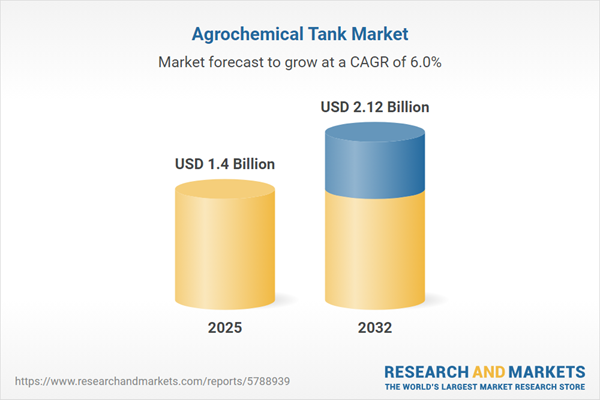Speak directly to the analyst to clarify any post sales queries you may have.
The agrochemical tank market is transforming as industry leaders confront evolving compliance obligations and environmental standards. Organizations are rethinking their chemical storage approaches to achieve efficiency, reliability, and seamless regulatory alignment in a complex global agricultural environment.
Market Snapshot: Agrochemical Tank Market Growth Outlook
The agrochemical tank market rose from USD 1.32 billion in 2024 to USD 1.40 billion in 2025, and it is forecast to reach USD 2.12 billion by 2032 at a compound annual growth rate of 6.03%. Growth is propelled by rapid technological integration within storage solutions, ongoing regulatory changes, and a sector-wide shift toward sustainability. Agricultural organizations, ranging from small-scale farms to large industrial enterprises, are investing in advanced tank systems to enhance resource efficiency and streamline workflows. Technological developments, such as automation and digital monitoring, are enabling innovation and improved management of chemical handling across all geographies and operational scales.
Scope & Segmentation of the Agrochemical Tank Market
- Application Areas: Tanks facilitate the storage of fertilizers, fungicides, herbicides, and insecticides, supporting varied needs from modest agricultural plots to expansive commercial operations.
- Tank Types: Bulk tanks, intermediate (including skid-mounted and stackable), and mobile units offer flexibility for both stationary and portable deployment.
- Material Types: Carbon steel delivers robust durability, stainless steel adds corrosion resistance and sanitation, while polyethylene offers lightweight advantages for high-demand settings.
- Capacity Ranges: Options below 500 liters, between 500 and 2000 liters, and above 2000 liters enable tailored scalability for storage or application requirements.
- End Users: Farms, agricultural contractors, cooperatives, and distributors integrate tanks to optimize workflows and maintain consistent service levels.
- Distribution Channels: Aftermarket services, direct sales, and online platforms extend procurement flexibility and supplier engagement.
- Operation Modes: Fully automatic, semi-automatic, and manual systems are chosen to match automation demands, field mobility, and adaptability needs.
- Pressure Types: Atmospheric and pressurized solutions meet safety standards and chemical compatibility for diverse operational contexts.
- Mobility Options: Stationary and portable tanks accommodate evolving logistics and operation-scale requirements.
- Regional Focus: Practices differ across the Americas, Europe, Middle East & Africa, and Asia-Pacific, shaped by regional compliance, usage patterns, and deployment strategies.
- Key Market Players: Deere & Company, AGCO Corporation, CNH Industrial N.V., Mahindra & Mahindra Limited, Kubota Corporation, Yanmar Holdings Co., Ltd., Agrifac International B.V., Hardi International A/S, Berthoud SA, and Tecnoma SAS play key roles in market innovation and segmentation.
Key Takeaways and Strategic Insights
- Sensor integration and IoT-based monitoring are now standard in many tank systems, enabling real-time data on tank status and contributing to more efficient maintenance and compliance.
- Materials such as innovative alloy blends and biodegradable liners are gaining traction for their combined durability, cost-efficiency, and environmental benefits, allowing users to manage assets with reduced ecological impact.
- Modern containment advances—like leak-proof seals and automated washdown systems—help organizations uphold rigorous chemical safety and environmental stewardship standards.
- Regional adoption varies: the Americas prefer centralized, larger-scale tank infrastructures, while Asia-Pacific leans toward agile, smart tanks tailored for smaller-scale operations and technology-driven management.
- Strategic partnerships between tank manufacturers and digital technology firms are accelerating tank integration within holistic farm management and resource planning systems.
Tariff Impact
New United States tariffs, effective in 2025, are affecting global procurement of agrochemical tank components. Manufacturing organizations are responding with diversified sourcing, investment in local suppliers, and more nearshoring of key materials. These shifts underscore the need for agile purchasing approaches and reinforce long-term supply chain resilience across the market.
Methodology & Data Sources
This market research is grounded in executive interviews, extensive industry literature reviews, and verification of the full supply chain. Quantitative insights have undergone triple validation to deliver dependable, actionable intelligence for stakeholders invested in agrochemical tank technology.
Why This Report Matters
- Provides leadership with unbiased, actionable intelligence to navigate evolving regulatory frameworks and integrate next-generation technology in agrochemical tank operations.
- Supports procurement and investment leaders seeking guidance on strategic upgrades, technology adoption, and digital management within chemical storage ecosystems.
- Enables decision-makers to anticipate risks, align resources, and optimize asset cycle management as market conditions evolve.
Conclusion
Drawing on these findings, industry leaders can strengthen operational alignment, manage emerging challenges, and secure long-term competitive advantage as the agrochemical tank market continues to evolve.
Additional Product Information:
- Purchase of this report includes 1 year online access with quarterly updates.
- This report can be updated on request. Please contact our Customer Experience team using the Ask a Question widget on our website.
Table of Contents
3. Executive Summary
4. Market Overview
7. Cumulative Impact of Artificial Intelligence 2025
List of Figures
Companies Mentioned
The key companies profiled in this Agrochemical Tank market report include:- Deere & Company
- AGCO Corporation
- CNH Industrial N.V.
- Mahindra & Mahindra Limited
- Kubota Corporation
- Yanmar Holdings Co., Ltd.
- Agrifac International B.V.
- Hardi International A/S
- Berthoud SA
- Tecnoma SAS
Table Information
| Report Attribute | Details |
|---|---|
| No. of Pages | 186 |
| Published | October 2025 |
| Forecast Period | 2025 - 2032 |
| Estimated Market Value ( USD | $ 1.4 Billion |
| Forecasted Market Value ( USD | $ 2.12 Billion |
| Compound Annual Growth Rate | 6.0% |
| Regions Covered | Global |
| No. of Companies Mentioned | 11 |









